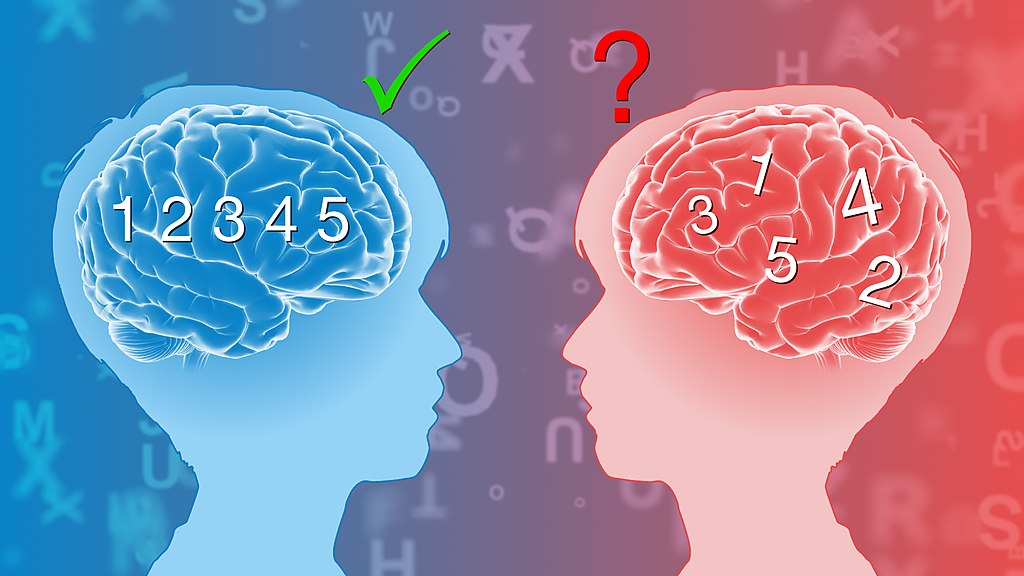Nebula Genomics DNA Report for Dyslexia
Is dyslexia genetic? We created a DNA report based on a study that attempted to answer this question. Below you can see a SAMPLE DNA report. To get your personalized DNA report, purchase our Whole Genome Sequencing!

Table of contents
What is Dyslexia?
Developmental dyslexia is a complex, language-based learning disorder that affects an individual’s information-processing capabilities. The condition often interferes with the ability to read, write, and spell.
People with dyslexia have trouble relating written letters to sounds, which causes problems with accurate and fluent word writing, reading, and spelling. The condition is not a reflection of an individual’s intelligence or vision. On the other hand, it is caused by differences in how the brain processes and interprets language.
Dyslexia is a learning disability that usually emerges in childhood and continues into adulthood. There is no cure but early assessment and intervention improves outcomes in school and learning in general.
Types of dyslexia
Phonological: This is the most common type of dyslexia and affects a person’s ability to associate letters to sounds. People have difficulty sounding out words and may struggle with word recognition.
Surface: This type affects a person’s ability to recognize and remember words by sight. People may struggle with irregular words (words that don’t follow typical spelling rules) due to the need to sound out every word they read.

Rapid naming deficit dyslexia: People have difficulty quickly naming letters, colors, or objects. This can affect their ability to read and write fast.
Double deficit dyslexia: This type involves both phonological awareness and rapid naming deficits. People may struggle with sounding out words and quickly recognizing them by sight.
Visual dyslexia: People with visual dyslexia have difficulty remembering visual information on a page. This may result from the brain not getting a complete picture of what the eyes see, affecting a person’s ability to recognize letters and words.
Deep: Deep dyslexia is a form of acquired dyslexia that results from trauma to the brain’s left hemisphere. This type affects someone’s ability to sound out nonsense words. It also involves semantic errors—substituting one word for a related one while reading.
The condition presents differently, and many people may have a combination of these types.
Is Dyslexia Genetic?
Dyslexia tends to run in families. That is, children with a parent or sibling with dyslexia are more likely to develop the condition themselves. Genetic studies show that the risk of developing dyslexia is 40-60% higher if a close family member has the disorder, suggesting a strong genetic component. Experts specifically identified genes in regions 1p34–p36, 6p21–p22, 15q21 and 18q11.
But what exactly is the genetic link to dyslexia? Previous studies have identified several risk variants that appear to influence the disorder’s development. Experts believe these genes affect language processing and reading comprehension, making it more difficult to recognize and decode words.
The 2022 study highlighted in this article was led by researchers from researchers at the University of Edinburgh and the Max Planck Institute for Psycholinguistics in Nijmegen (Netherlands). It is the first large scale study to reliably associate genetic factors with dyslexia.
Sample genes
DCDC2: A gene involved in binding tubulin and enhancing microtubule polymerization. Doctors frequently find changes in this genetic factor in individuals with dyslexia.
KIAA0319: This gene encodes a protein expressed on the cell membrane and may be involved in neuronal migration. Specifically, it is involved in early brain development.
DYX1C1: This gene codes for a protein known as Dyslexia susceptibility 1 candidate gene 1 protein, found in cortical neurons and white matter glial cells. It may also play a role in neuronal migration.
ROBO1: Plays a role in the development of the nervous system. The gene encodes a protein that acts as an axon guidance receptor and a cell adhesion receptor, known to be involved in the decision by axons to cross the central nervous system midline.
CNTNAP2: This gene is involved in the development and function of neural connections in the brain. A 2018 study suggests that this gene is associated with dyslexia development in females but not males.
Epidemiology
Dyslexia is a common learning disorder that affects a large number (up to 20%) of the world’s population.
Prevalence depends on the criteria used to define poor reading skills and standards can be widely variable. This is why searching for prevalence can reveal values as low as 1% and as high as 20%. Experts typically use 7% as a good worldwide estimate. Studies that use strict standards for diagnosis tend to report lower prevalence rates, while those that use broader criteria report higher rates.
It is more prevalent in males than females, with an estimated male-to-female ratio of 3:1. The disorder is found across all cultures and socioeconomic backgrounds, and there is no known relationship between race or ethnicity and the incidence of dyslexia.
Some studies have found that the incidence of dyslexia may be decreasing over time, although this is not yet well-established. Factors contributing to a decrease in dyslexia incidence include improvements in education and literacy programs, changes in teaching methods, and increased awareness and recognition of the disorder.
Symptoms
The condition can present with a wide range of symptoms, varying in severity and type from person to person. Parents may not notice symptoms until their child starts school and starts to show reading problems.

Before starting school a child may show early signs such as late talking, learning new words slowly, confusing sounds, and problem remembering letters and objects.
At school, the condition often becomes more apparent:
- Difficulty in reading and writing: Children with dyslexia may read slowly, skip words or lines, or need help understanding the meaning of what they read.
- Trouble with phonological processing: Children may have difficulty recognizing and working with the sounds in words.
- Challenges with working memory: Working memory is the ability to hold information in mind and use it to complete a task. Children may find it harder to follow multi-step instructions or remember information quickly.
- Difficulty with sequencing: Children may struggle with tasks that require sequencing, such as organizing thoughts in writing or telling a story in a logical order.
- Poor spatial awareness: Children may have trouble with spatial awareness, making it difficult to distinguish between similar letters or words that look alike.
- Difficulty with time management: A person with dyslexia may have difficulty with time management. This comes from trouble with organization, impacting ability to complete tasks efficiently and effectively.
Dyslexia can also be classified as mild, moderate, or severe.
Causes
The causes of dyslexia are not fully understood. However, experts know that dyslexia occurs from differences in the parts of the brain that enable reading ability. Because it tends to run in families doctors believe dyslexia is linked to certain genetic variants. Additional research suggests that environmental factors and genetic factors may contribute to its development.
Some possible causes include:
- Differences in brain structure and function.
- Inheritance of genes that are related to dyslexia
- Family history of dyslexia
- Premature birth or low birth weight
- Exposure to harmful substances, such as nicotine, drugs, and alcohol during pregnancy may affect fetal brain development
- Brain development of the fetus may alter due to infections in the mother during pregnancy
- Exposure to stress at a very young age
- Though dyslexia is present at birth, adults with brain injury, stroke, or dementia may develop the symptoms of dyslexia
Diagnosis
There is no single test to diagnose the condition and it cannot be diagnosed through lab or blood tests. Therefore, diagnosis of dyslexia typically involves a comprehensive evaluation of an individual’s developmental, medical, and educational history, as well as standardized assessments of reading fluency and writing skills.
The following are some of the critical components of the diagnostic process:
Developmental, medical, and educational history: A thorough review of an individual’s background, including their family history, medical history, educational history, and any previous assessments or interventions.
Standardized assessments: These educational tests assess an individual’s reading and writing skills. These may include the Woodcock-Johnson Tests of Achievement, the Kaufman Assessment Battery for Children, or other similar assessments. Typically, reading experts review and interpret the results.
Cognitive tests: Assessment of cognitive abilities such as intelligence, memory, and processing speed using tools such as the Wechsler Intelligence Scale for Children or the Stanford-Binet Intelligence Scale.
Behavioral observations: Gather information about the individual’s behavior and learning style through teacher reports, parent interviews, and classroom observations. A psychological evaluation can help determine if learning disabilities involve a mental disorder.
Vision, hearing and brain (neurological) tests: These can rule out other causes for a learning disability.
It’s important to note that the specific process of diagnosing dyslexia may vary depending on the professional conducting the assessment and the particular tools and procedures used.
The diagnosis of dyslexia should always involve a thorough evaluation of an individual’s strengths and weaknesses and an understanding of the individual’s unique needs and challenges.
Treatment
Doctor’s are unable to correct the brain differences that underlie the condition. However, early detection and interventions can help children manage the condition and learn to read efficiently. The treatment of dyslexia typically involves a multi-faceted approach that addresses the individual’s specific learning needs and challenges.
Some common treatments and interventions for dyslexia include:
Reading intervention programs: These involve individual teaching programs at school that use alternative methods to help children process words. Approaches include reading aloud, listening to taped lessons, and using a finger to trace letters.
One-on-one tutoring or special instruction: These sessions usually take place with a reading specialist, special education teacher, or speech-language pathologist.
[Image: Dyslexia intervention. Shutterstock]
The use of assistive technology: Technology such as text-to-speech software, speech recognition software, or digital tools that can help with note-taking and organization.
Support and accommodations: In the United States, schools are required to create an Individual Development Plans (IDPs) to help students with specific learning disabilities like dyslexia. This includes extra time on tests, the use of audiobooks, or the provision of visual aids.
Multisensory and structured language instruction: It engages multiple senses and focuses on the building blocks of language, such as phonemes, syllables, and morphology.
If you liked this article, you should check out our other posts in the Nebula Research Library!
August 22, 2023
